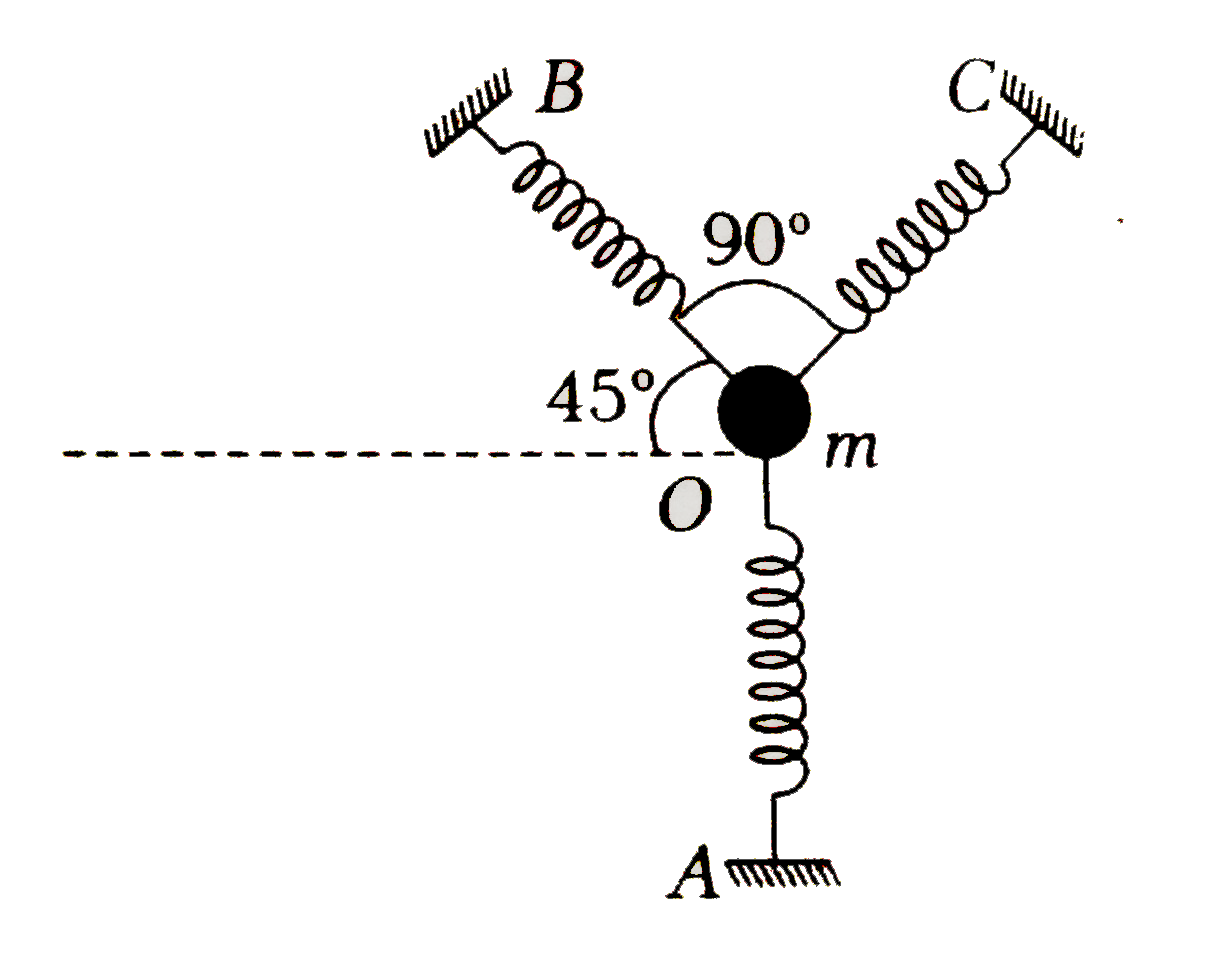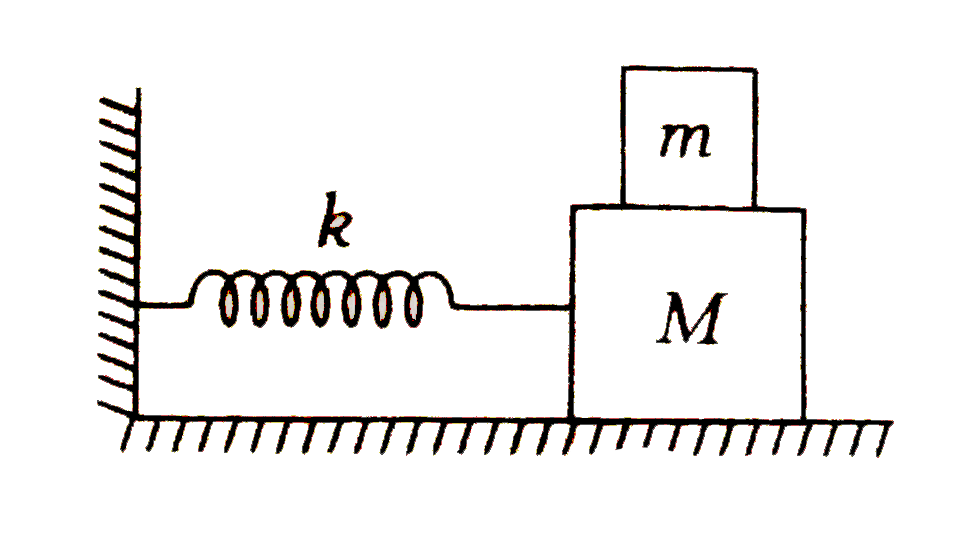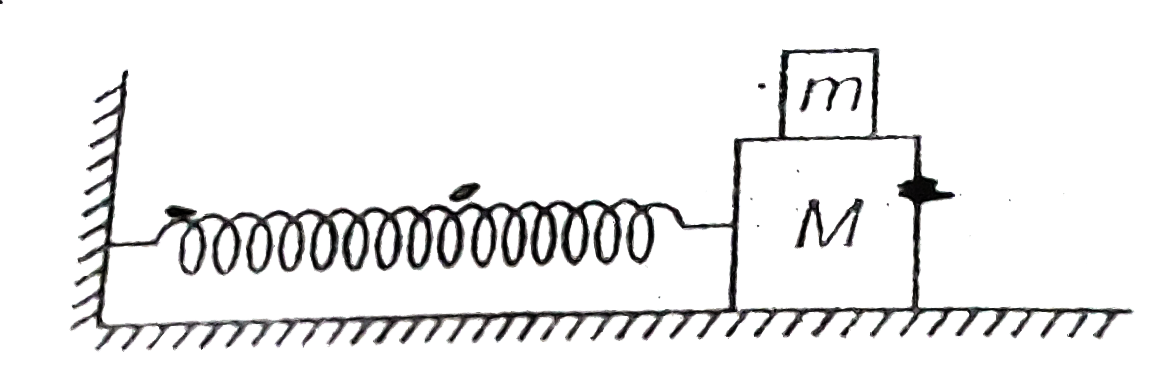A block with mass M attached to a horizontal spring with force constant k is moving with simple harmonic motion having amplitude A1. At the instant when the block passes through its equilibrium position a lump of putty with mass m is dropped vertically on the block from a very small height and sticks to it.
(a) Find the new amplitude and period.
(b) Repeat part (a) for the case in which the putty is dropped on the block when it is at one end of its path.
The correct Answer is:A, B
To solve the problem step by step, we will break it down into two parts as requested:
Part (a): New Amplitude and Period when Putty is Dropped at Equilibrium Position
1. Identify Initial Conditions:
- Mass of the block = M
- Spring constant = k
- Initial amplitude = A1
- Initial period T1=2π√Mk
2. Determine the New Mass:
- When the putty of mass m sticks to the block, the new mass M′=M+m.
3. Calculate the New Period:
- The new period T2 can be calculated using the formula:
T2=2π√M′k=2π√M+mk
4. Determine the New Amplitude:
- At the equilibrium position, the velocity of the block is maximum. The maximum velocity vmax of the block before the putty sticks can be calculated as:
vmax=A1ω1=A1⋅√kM
- After the putty sticks, the new amplitude A2 can be found using conservation of momentum. The momentum before the putty sticks is equal to the momentum after:
Mvmax=(M+m)vnew
- Rearranging gives:
vnew=MvmaxM+m
- The new amplitude can be calculated using:
A2=vnewω2=Mvmax(M+m)√kM+m
- Substituting vmax into the equation gives:
A2=MA1√kM(M+m)√kM+m
Part (b): New Amplitude and Period when Putty is Dropped at One End of the Path
1. Identify Initial Conditions:
- The initial conditions remain the same as in part (a).
2. Determine the New Mass:
- The new mass M′=M+m remains unchanged.
3. Calculate the New Period:
- The new period T2 remains the same as in part (a):
T2=2π√M+mk
4. Determine the New Amplitude:
- When the putty is dropped at one end of the path, the block is momentarily at rest. Thus, the new amplitude A2 can be calculated as:
- The total energy in the system before the putty sticks is:
E=12kA21
- After the putty sticks, the energy will be:
E′=12(M+m)v2new+12kA22
- Setting the energies equal gives:
12kA21=12(M+m)v2new+12kA22
- Since vnew=0 at the end of the path, we can simplify to find A2:
kA21=kA22⟹A2=A1√MM+m
Summary of Results:
- New Period:
T2=2π√M+mk
- New Amplitude:
- When dropped at equilibrium position:
A2=A1√MM+m
- When dropped at one end of the path:
A2=A1√MM+m
- Mass of the block = M
- Spring constant = k
- Initial amplitude = A1
- Initial period T1=2π√Mk
- When the putty of mass m sticks to the block, the new mass M′=M+m.
- The new period T2 can be calculated using the formula:
T2=2π√M′k=2π√M+mk
- At the equilibrium position, the velocity of the block is maximum. The maximum velocity vmax of the block before the putty sticks can be calculated as:
vmax=A1ω1=A1⋅√kM
- After the putty sticks, the new amplitude A2 can be found using conservation of momentum. The momentum before the putty sticks is equal to the momentum after:
Mvmax=(M+m)vnew
- Rearranging gives:
vnew=MvmaxM+m
- The new amplitude can be calculated using:
A2=vnewω2=Mvmax(M+m)√kM+m
- Substituting vmax into the equation gives:
A2=MA1√kM(M+m)√kM+m
- The initial conditions remain the same as in part (a).
- The new mass M′=M+m remains unchanged.
- The new period T2 remains the same as in part (a):
T2=2π√M+mk
- When the putty is dropped at one end of the path, the block is momentarily at rest. Thus, the new amplitude A2 can be calculated as:
- The total energy in the system before the putty sticks is:
E=12kA21
- After the putty sticks, the energy will be:
E′=12(M+m)v2new+12kA22
- Setting the energies equal gives:
12kA21=12(M+m)v2new+12kA22
- Since vnew=0 at the end of the path, we can simplify to find A2:
kA21=kA22⟹A2=A1√MM+m
- New Period:
T2=2π√M+mk
- New Amplitude:
- When dropped at equilibrium position:
A2=A1√MM+m
- When dropped at one end of the path:
A2=A1√MM+m
Topper's Solved these Questions
- BOOK - DC PANDEY ENGLISHCHAPTER - SIMPLE HARMONIC MOTIONEXERCISE - Level 2 Single Correct28videos
SIMPLE HARMONIC MOTION
- BOOK - DC PANDEY ENGLISHCHAPTER - SIMPLE HARMONIC MOTIONEXERCISE - Level 2 More Than One Correct8videos
SIMPLE HARMONIC MOTION
- BOOK - DC PANDEY ENGLISHCHAPTER - SIMPLE HARMONIC MOTIONEXERCISE - Level 1 Single Correct24videos
SIMPLE HARMONIC MOTION
- BOOK - DC PANDEY ENGLISHCHAPTER - SEMICONDUCTORS AND ELECTRONIC DEVICESEXERCISE - More than One Option is Correct3videos
SEMICONDUCTORS AND ELECTRONIC DEVICES
- BOOK - DC PANDEY ENGLISHCHAPTER - SOLVD PAPERS 2017 NEET, AIIMS & JIPMEREXERCISE - Solved paper 2018(JIPMER)38videos
SOLVD PAPERS 2017 NEET, AIIMS & JIPMER
Similar Questions
A particle performs simple harmonic motion wit amplitude A. its speed is double at the instant when it is at distance A3 from equilibrium position. The new amplitude of the motion is
View SolutionA horizontal spring block system of mass M executes simple harmonic motion. When the block is passing through its equilibrium position, an object of mass m is put on it and the two move together. Find the new amplitude and frequency of vibration. Given, k is the spring constant of the system.
View SolutionA horizontal spring -block system of mass 2kg executes S.H.M when the block is passing through its equilibrium position an object of mass 1kg is put on it the two move together The new amplitude of vibration is (A being its initial amplitude)
View SolutionA horizontal spring -block system of mass 2kg executes S.H.M when the block is passing through its equilibrium position an object of mass 1kg is put on it the two move together The new amplitude of vibration is (A being its initial amplitude)
View SolutionA mass M is attached to a horizontal spring of force constant k fixed one side to a rigid support as shown in figure. The mass oscillates on a frictionless surface with time period T and amplitude A. When the mass M is in equilibrium position, another mass m is gently placed on it. When will be the new amplitude of ocillation?

 View Solution
View SolutionA block of mass M attached to the free end of a spring of force constant k is nounted on a smooth horizontal table as shown in figure.

The block executes SHM with amplitude A and frequency f . If an object of mass m is put on it, when the block is passing through its equilibium position and the two move together ,then what is the new amplitude and frequency of vibration?View SolutionA particle performs simple harmonic motion with amplitude A. Its speed is tripled at the instant that it is at a distance
2A3 from equilibrium position. The new amplitude of the motion is:View SolutionA block of mass m suspended from a spring of spring constant k. Find the amplitude of S.H.M.
View SolutionA particle performs simple harmonic motion with amplitude A. its speed is double at the instant when it is at distance A3 from equilibrium position. The new amplitude of the motion is √33Aβ. Find β
View SolutionA mass M, attached to a horizontal spring, excutes SHM with a amplitude A1. When the mass M passes through its mean position then a smaller mass m is placed over it and both of them move together with amplitude A2, the ratio of (A1A2) is :
View Solution

